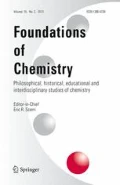This issue brings a special issue devoted to the ISPC meeting in San Francisco to a conclusion with three remaining articles. These papers, authored by three prominent philosophers of chemistry will be introduced more fully by Professor Tami Spector in an accompanying editorial to follow.
Here I confine myself to commenting a little on the remaining two articles.Footnote 1 First of all Richard Pagni has produced a detailed account of the standard model of elementary particle physics and the relationship of this work to the somewhat exotic field of the optical rotation observed in atoms. Optical rotation due to a lack of reflection symmetry is of course part and parcel of any course in organic chemistry and a phenomenon that is very well-known to all chemists. What Pagni describes here is a more surprising form of optical rotation that is present in principle in all atoms, although it has only been observed so far in atoms of bismuth, thallium, samarium and lead. The first such observation was carried out by Sandars et al. on bismuth atoms in 1991.
The importance of this work is that it could provide an explanation for the formation of optically active molecules in the pre-biotic world and might thus play a prominent role in theories on the origin of life. The notion that parity violation in the weak-nuclear force might be the cause of this phenomenon has been put forward by many researchers but the possible mechanism did not present itself until these recent findings on optically active atoms, although as Pagni also explains there are now other candidate mechanisms available.
The other paper that is not part of the ISPC special issue is by Geoffrey Rayner Canham, the author of perhaps the best known textbook on descriptive inorganic chemistry which is now in its fourth edition.Footnote 2 In the present article he gives a diverse collection of isoelectronic series, although he carefully distinguishes between strictly isoelectronic, valence isoelectronic and finally pseudo-isoelectronic. The last of these categories involves elements such as vanadium and arsenic or chromium and selenium where the first and second member of such pairs differ by ten d-electrons and belong to the n and n + 10 groups of the periodic table, respectively. One interesting feature of these pairs of elements is that they occurred in the same columns in the early short-form periodic tables published by MendeleevFootnote 3 and other pioneers.Footnote 4
This final point leads nicely to another special issue on the periodic system which is currently being complied and edited by the South African chemist Michael Laing and which will appear in due course.
Notes
As a matter of fact Richard Pagni was also a presenter at the San Francisco ISPC meeting and his paper appeared in the previous issue, R. M. Pagni, The origin and development of the acidity function, Foundations of Chemistry, 11, 43–50, 2009.
G. Rayner Canham, T. Overton, Descriptive Inorganic Chemistry, Freeman, San Francisco, 2006.
However, some medium-long form tables, as they are known these days, were also published by Mendeleev and later by Werner and some others.
E. R. Scerri, Periodic Change, Chemistry World, March 2009, 46–49.
Open Access
This article is distributed under the terms of the Creative Commons Attribution Noncommercial License which permits any noncommercial use, distribution, and reproduction in any medium, provided the original author(s) and source are credited.
Author information
Authors and Affiliations
Corresponding author
Rights and permissions
Open Access This is an open access article distributed under the terms of the Creative Commons Attribution Noncommercial License (https://creativecommons.org/licenses/by-nc/2.0), which permits any noncommercial use, distribution, and reproduction in any medium, provided the original author(s) and source are credited.
About this article
Cite this article
Scerri, E.R. Editorial 32. Found Chem 11, 61–62 (2009). https://doi.org/10.1007/s10698-009-9072-y
Published:
Issue Date:
DOI: https://doi.org/10.1007/s10698-009-9072-y

